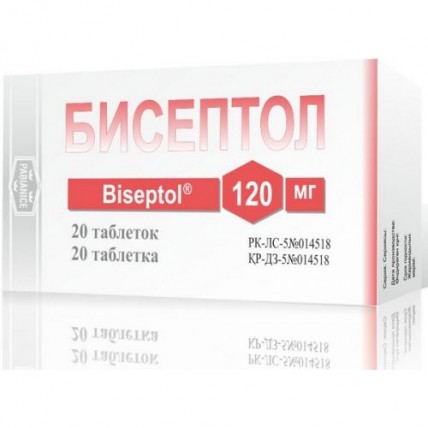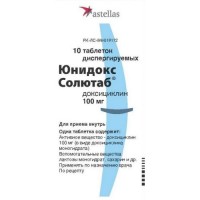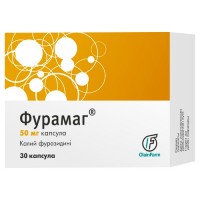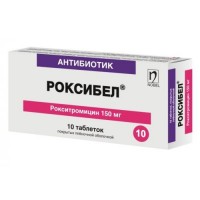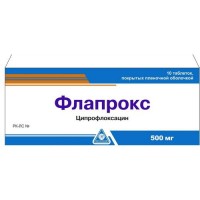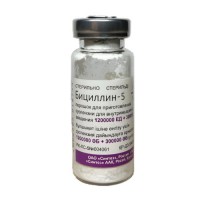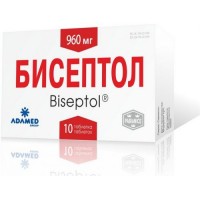Biseptolum 120 mg (20 tablets)
- $4.90
Sku:
8c82a9f9781f
Ingredient:
Co-Trimoxazole
The instruction for medical use
of BISEPTOLUM medicine
the Trade name
Biseptolum
the International unlicensed name
Is not present
the Dosage form
of the Tablet 120 mg, 480 mg
Structure
One tablet contains
active agents: Trimethoprimum of 20 mg, 80 mg,
sulfamethoxazole of 100 mg, 400 mg,
excipients: potato starch, talc, magnesium stearate, polyvinyl alcohol, methylparahydroxybenzoate, propilparagidroksibenzoat, propylene glycol.
The description
of the Tablet from color, white to white with a yellowish shade, round shape, with a flat surface, with a facet, with Bs engraving on one party, with a diameter from 7.8 to 8.3 mm (for a dosage of 120 mg).
Tablets from color, white to white with a yellowish shade, round shape, with a flat surface, with a facet, risky and an engraving of Bs over risky on one party, with a diameter from 12.80 to 13.40 mm (for a dosage of 480 mg).
Pharmacotherapeutic group
Antibacterial drugs for system use. Streptocides and trimeto uses Streptocides in a combination with Trimethoprimum and its derivatives. Co-trimoxazole.
The ATX J01EE 01 code
the Pharmacological
Pharmacokinetics Both Components properties of drug are quickly soaked up from a digestive tract, the maximum concentration of both components in blood serum is reached in 1-4 hours after intake. The volume of distribution of Trimethoprimum is about 130 l, sulfamethoxazole - about 20 l. 45% of Trimethoprimum and 66% of sulfamethoxazole are connected with proteins of plasma.
Distribution of both connections differs, streptocide is distributed only in extracellular space, Trimethoprimum spreads in all fluid mediums of an organism. High concentration of Trimethoprimum is observed, including, in discharges of bronchial glands, a prostate and in bile. Concentration of sulfamethoxazole in biological liquids are lower. Both connections appear in effective concentration in a phlegm, vaginal discharge and liquid of a middle ear.
The volume of distribution of sulfamethoxazole is 0.36 dm3kg, Trimethoprimum - 2.0 dm3kg.
Both drugs are metabolized in a liver, streptocide by acetylation and linking with glucuronic acid, Trimethoprimum by oxidation and hydroxylation.
Both drugs are removed from an organism generally through kidneys, as by filtration, and active canalicular secretion. Concentration of active connections in urine are much higher, than in blood. Within 72 hours with urine 84.5% of the accepted dose of streptocide and 66.8% of Trimethoprimum are removed.
Elimination half-life makes of serum according to 10 h for sulfamethoxazole and 8-10 h for Trimethoprimum.
Both sulfamethoxazole, and Trimethoprimum get into female milk and the blood circulatory system of a fruit.
The pharmacokinetics in special clinical cases
Patients of advanced and senile age
At normal function of kidneys elimination half-life of both components of drug changes slightly.
Patients with a renal failure
At patients with a renal failure (clearance of creatinine of 15-30 ml/min.), elimination half-life of both components of drug increase that demands dose adjustment.
A pharmacodynamics
the Combined bactericidal drug containing the sulfamethoxazole, streptocide with an average duration of action inhibiting synthesis of folinovy acid by competitive antagonism with paraaminobenzoic acid and Trimethoprimum, inhibitor of bacterial reductase of the degidrofolinovy acid responsible for synthesis of biologically active tetragidrofolinovy acid. The combination of the components operating on the same chain of biochemical transformations results in synergism of antibacterial action, consider that thanks to a combination of two active agents the development of stability of bacteria happens more slowly, than in case of use of one active agent.
Co-trimoxazole is bactericidal drug of a broad spectrum of activity, is active concerning almost all groups of microorganisms - gram-negative bacteria: Salmonella spp., Shigella spp., Neisseria spp., Proteus vulgaris, Vibrio cholerae, Yersinia spp., Escherichia coli, Corynebacterium spp., gram-positive bacteria: Staphylococcus spp. and others. Chlamydia spp., Actinomyces spp., Klebsiella spp are also sensitive to drug.
Indications
Treatment of the infectious and inflammatory diseases caused by microorganisms, sensitive to drug:
- the acute otitis of a middle ear at children caused by Str strains, sensitive to drug. pneumoniae and H. influenzae
- the exacerbation of chronic bronchitis at adults caused by strains of Streptococcus pneumoniae
or H. influenzae, sensitive to drug, if, according to the doctor, use of the combined drug is more effective, than monotherapy
- the pneumonia confirmed with microbiological researches caused by Pneumocystis carinii, and prevention of infection with this microorganism of patients from group of the increased risk (for example, infected with AIDS)
- the infections of urinary tract at adults and children caused by strains of E. coli, Klebsiella sp., Enterobacter sp., Morganella morganii, Proteus mirabilis and Proteus vulgaris, sensitive to drug (except for not complicated infections)
- the infections of a digestive tract at adults and children caused by sticks of Shigella flexneri and Shigella sonnei if antibacterial therapy is shown), the diarrhea of travelers caused by enterotoksichesky strains of Escherichia coli, cholera (in addition to completion of liquid and electrolytes).
The route of administration and doses
Drug is used inside after a meal with enough liquid.
Children are from 6 to 12 years old: 240-480 mg 2 times a day in 12 hours.
Adults and children are more senior than 12 years: 960 mg once, or 480 mg 2 times a day. The daily dose should not exceed 1920 mg (4 tablets on 480 mg).
The course of treatment makes from 7 to 10 days. In persistent infections a course of treatment longer also depends on weight of a disease.
In acute infectious diseases a course treatment of 5 days if after 7 days there is no clinical improvement, it is necessary to consider carrying out correction of treatment in connection with possible resistance of the activator.
Dosing in special cases:
The pneumonia caused by Pneumocystis carinii in adults and children:
Max the daily dose for patients with the diagnosed infection makes 90-120 mg/kg of body weight of Biseptolum divided into the parts accepted each 6 hours within 14 days.
Prevention of infection of Pneumocystis carinii and toxoplasmosis:
Adults and children are more senior than 12 years: 960 mg of Biseptolum (two tablets on 480 mg) once a day.
Children from 6 to 12 years: 960 mg the day of Biseptolum divided into two equal receptions in 12 hours during trkh days. The daily dose should not exceed 1920 mg (4 tablets on 480 mg).
Patients with clearance of creatinine of 15-30 cm3/min. should reduce a dose twice, at clearance of creatinine less than 15 cm3/min. use of co-trimoxazole is not recommended.
Patients of advanced age
the Drug should be taken carefully to patients of advanced age owing to increase in risk of side effects, especially at patients with a renal/liver failure or accepting at the same time other medicines.
In the absence of special instructions it is necessary to accept standard doses of drug.
Side effects
Often
- nausea, vomiting
- rash,
naggers Redko
- an agranulocytosis, aplastic anemia, hemolytic anemia, megaloblastny anemia, an eosinophilia, a prothrombinopenia, a leukopenia, a methemoglobinemia, a neutropenia, thrombocytopenia, an autoimmune or aplastic pancytopenia, a granulocytopenia
- allergic myocarditis, a fever, medicamentous fever, kollikvatsionny necrosis of skin, a photosensitization, anaphylactic reactions, vasomotorial hypostasis, a skin itching, allergic rash, Shenleyna-Genokh's disease, a small tortoiseshell, a polymorphic erythema, generalized skin reactions, exfoliative dermatitis, a syndrome of a serum disease, Stephens-Johnson's syndrome, a Lyell's disease (a toxic epidermal necrolysis, symptoms of supersensitivity of respiratory organs, a nodular periarteritis, a volchanopodobny syndrome, hyperaemia of a conjunctiva and sclera of an eye
- a diarrhea, an abdominal pain, lack of appetite, nausea, lozhnodifteriyny inflammation of intestines, vomiting, increase in level of transaminases and creatinine in blood serum, inflammation of an oral cavity, inflammation of language, pancreatitis, hepatitis, sometimes with cholestatic jaundice or necrosis of a liver
- a crystalluria, a renal failure, interstitial nephrite, a nephrotoxic syndrome with an oliguria or an anury, increase in nonprotein nitrogen and creatinine of serum, increase in a diuresis (at patients with hypostases of warm origin)
- a hypopotassemia, a hyponatremia, a hyperglycemia
- apathy, aseptic meningitis, an ataxia, a headache, a depression, spasms, hallucinations, nervousness, sonitus, inflammation of peripheral nerves, dizziness, weakness, feeling of fatigue, insomnia
- joint pains, muscular pains, a rhabdomyolysis
- suffocation, cough, infiltrates in lungs.
Contraindications
- hypersensitivity to drug, its components, drugs from group of co-trimoxazole
- heavy damages of a parenchyma of a liver, a hyperbilirubinemia (at children)
- an acute renal failure in which it is impossible to define concentration of medicine in blood plasma
- blood diseases (aplastic anemia, B12-scarce anemia, an agranulocytosis, a leukopenia)
- a concomitant use with dofetilidy
- the shortage of dehydrogenase glyukozo-6-phosphatic (probability of emergence of hemolysis)
- pregnancy and the period of a lactation.
- children's age up to 6 years
With care appoint drug at deficiency of folic acid in an organism, bronchial asthma, diseases of a thyroid gland.
Medicinal interactions
Dofetilid can become the cause of ventricular arrhythmias with lengthening of an interval of QT, including torsades de pointes which are directly connected with concentration of a dofelitid in blood plasma.
At a concomitant use of some diuretics (generally tiazid), risk of developing thrombocytopenia, especially at patients of advanced and senile age increases.
Biseptolum can enhance effect of anticoagulants in the degree demanding modification of a dose.
Biseptolum slows down Phenytoinum metabolism. At the patients taking both drugs, duration of elimination half-life of Phenytoinum increases approximately by 39%, and the clearance of Phenytoinum decreases approximately by 27%.
Biseptolum increases concentration of free fraction of a methotrexate in serum due to replacement it from bonds with proteins.
Influence on results of laboratory researches.
Trimethoprimum can affect results of definition of concentration of a methotrexate in serum by an euzymatic method, but does not affect them if definition is carried out by radio immunological methods.
Biseptolum can overestimate approximately by 10% test results of Jaffe with the main picrate on creatinine.
Biseptolum can exponentiate effect of the taken at the same time hypoglycemic medicines derivative of sulphonylurea, and thus to increase risk of development of a hypoglycemia.
Biseptolum can increase concentration of digoxin in plasma at some patients of advanced age.
Biseptolum can reduce efficiency of tricyclic antidepressants.
At patients is after transplantation of a kidney, treated Biseptolum and cyclosporine, the tranzitorny dysfunctions of a transplantirovanny kidney demonstrating increase in level of creatinine in serum that is possibly caused by effect of Trimethoprimum are observed.
Biseptolum with Pyrimethaminum can cause megaloblastny anemia.
Streptocides show chemical similarity to some anti-thyroid drugs, diuretic drugs (acetazoleamide and tiazida) and also oral antidiabetic drugs that can be the cause of a cross allergy.
Special instructions
Are described exceptional cases of the life-threatening complications connected with intake of streptocides, including Stephens-Johnson's syndrome, a Lyell's disease, acute necrosis of a liver, aplastic anemia, other injuries of marrow and a sensitization of airways.
If during treatment by Biseptolum there are symptoms indicating a possibility of complications, especially rash, a sore throat, the increased temperature, joint pains, cough, suffocation or hepatitis, it is necessary to stop administration of drug and to see immediately a doctor.
It is not recommended to apply in the tonsillitis, pharyngitises caused by a beta and hemolytic streptococcus of group A because of widespread resistance of strains.
Use with care is necessary when prescribing co-trimoxazole for patients with deficiency of folic acid (the elderly people, persons having alcohol addiction, a sprue), a porphyria, dysfunctions of a thyroid gland, bronchial asthma and allergic reactions in the anamnesis. At appearance of skin rash or diarrhea against the background of treatment by Biseptolum, its reception should be stopped immediately.
With deficiency of glyukozo-6-phosphate of dehydrogenase Biseptolum can cause hemolysis in patients.
At patients of advanced age the risk of heavy side effects of Biseptolum, including injury of kidneys or a liver increases. Most often the described heavy side effects of Biseptolum at elderly patients are strong skin reactions, oppression of marrow and also thrombocytopenia with a purpura or without purpura. Joint intake of Biseptolum and diuretic drugs increases risk of a purpura.
The patients with AIDS accepting Biseptolum concerning diseases of the caused Pneumocystis carinii, a thicket have undesirable effects, especially rash, fever, a leukopenia, increase in level of aminotransferases in serum, a hypopotassemia and a hyponatremia.
When prescribing Biseptolum the patients who already receive anticoagulants should remember possible strengthening of anticoagulative effect. In such cases it is necessary to define a blood clotting time repeatedly.
Patients should not appoint drug with hereditary intolerance of fructose.
Neobkhodimimo to be careful at patients with a porphyria or dysfunction of a thyroid gland.
At the patients accepting Biseptolum in high doses it is regularly necessary to control potassium content in serum. High doses of Biseptolum what are used at treatment of pneumocystic pneumonia can lead to progressing, but to reversible increase in content of potassium in serum at considerable number of patients. Even reception of the recommended drug doses can cause a hyperpotassemia if it is appointed against the background of disturbances of potassium exchange, a renal failure or a concomitant use of the drugs provoking a hyperpotassemia.
At treatment by high doses of Biseptolum it is necessary to consider a possibility of development of a hypoglycemia, usually in several days after an initiation of treatment. The risk of a hypoglycemia is higher at patients with renal failures, liver diseases, malnutrition.
During intake of Biseptolum (the same as during intake of other antibacterial agents) the pseudomembranous coloenteritis of different degree of manifestation from easy to life-threatening can develop therefore timely diagnosis of this disease at patients who during use of antibacterial medicine had a diarrhea is important.
Treatment by antibacterial agents influences change of physiological flora of a colon and can cause excess increase in quantity of anaerobic sticks. The toxins produced by Clostridium difficile are one of the main reasons of development of a coloenteritis.
In cases of an easy course of a pseudomembranous coloenteritis usually there is enough cancellation of medicine, in more hard cases the correction of water and electrolytic balance, administration of the proteins and antibacterial agents active concerning Clostridium difficile (metronidazole or Vancomycinum) is necessary. It is not necessary to administer the medicines oppressing a vermicular movement or other drugs possessing the knitting action. The product contains parahydroxybenzoates which can cause allergic reactions (rash, an itching) and also propylene glycol which can cause the symptoms similar to a state after intake of alcoholic drinks.
It is necessary to avoid excessive solar and UF-radiations.
Features of influence of medicine on ability to manage transport means and potentially dangerous mechanisms.
At use of drug the emergence of such side effects as is possible: a headache, dizziness, spasms, nervousness and feeling of fatigue therefore it is necessary to show care when driving and potentially dangerous mechanisms.
Overdose
Symptoms: lack of appetite, kolikopodobny pains, nausea, vomiting, dizziness, headache, drowsiness, loss of consciousness. There can be fever, a hamaturia and a crystalluria. In later period the injury of marrow and hepatitis can develop. Prolonged use of high doses of Biseptolum can cause oppression of the marrow showing thrombocytopenia, a leukopenia or megaloblastichesky anemia for a long time.
Treatment: gastric lavages (no later than 2 h after administration of drug), plentiful drink, an artificial diuresis. Acidulation of urine accelerates Trimethoprimum removal, but can increase risk of crystallization of streptocide in kidneys. It is necessary to watch a blood picture, electrolytes of serum and other biochemical indicators of the patient. The hemodialysis is moderately effective, peritoneal dialysis is inefficient.
At emergence of symptoms of injury of marrow it is necessary to apply leykovorin, in a dose of 5-15 mg a day.
A form of release and packing
On 20 tablets in blister strip packaging from a film of polyvinylchloride and aluminum foil. 1 planimetric packing together with the instruction for use in the state and Russian languages is placed in a cardboard pack.
To Store storage conditions at a temperature not over 250C.
To store out of children's reach!
Not to use a period of storage of 5 years after an expiration date.
Prescription status
According to the prescription
the Producer
the Pabyanitsky pharmaceutical plant Polfa AO
of st. of the marshal Pilsudsky to 5, 95-200 Pabyanitsa, Poland
the Owner of the registration certificate:
The Pabyanitsky pharmaceutical plant Polfa AO
of st. of the marshal Pilsudsky to 5, 95-200 Pabyanitsa, Poland
the Address of the organization accepting in the territory of the Republic of Kazakhstan claims from consumers on quality of products (goods)
Representative office of JSC Pabyanitsky the pharmaceutical plant Polfa in PK 059000, Almaty, the street of Abay, house 109B, the business center Globe, floor 13, office 13-2. Ph. / fax: +7 (727) 2776977. E-mail:
To develop info.kz@adamed.com.pl
of BISEPTOLUM medicine
the Trade name
Biseptolum
the International unlicensed name
Is not present
the Dosage form
of the Tablet 120 mg, 480 mg
Structure
One tablet contains
active agents: Trimethoprimum of 20 mg, 80 mg,
sulfamethoxazole of 100 mg, 400 mg,
excipients: potato starch, talc, magnesium stearate, polyvinyl alcohol, methylparahydroxybenzoate, propilparagidroksibenzoat, propylene glycol.
The description
of the Tablet from color, white to white with a yellowish shade, round shape, with a flat surface, with a facet, with Bs engraving on one party, with a diameter from 7.8 to 8.3 mm (for a dosage of 120 mg).
Tablets from color, white to white with a yellowish shade, round shape, with a flat surface, with a facet, risky and an engraving of Bs over risky on one party, with a diameter from 12.80 to 13.40 mm (for a dosage of 480 mg).
Pharmacotherapeutic group
Antibacterial drugs for system use. Streptocides and trimeto uses Streptocides in a combination with Trimethoprimum and its derivatives. Co-trimoxazole.
The ATX J01EE 01 code
the Pharmacological
Pharmacokinetics Both Components properties of drug are quickly soaked up from a digestive tract, the maximum concentration of both components in blood serum is reached in 1-4 hours after intake. The volume of distribution of Trimethoprimum is about 130 l, sulfamethoxazole - about 20 l. 45% of Trimethoprimum and 66% of sulfamethoxazole are connected with proteins of plasma.
Distribution of both connections differs, streptocide is distributed only in extracellular space, Trimethoprimum spreads in all fluid mediums of an organism. High concentration of Trimethoprimum is observed, including, in discharges of bronchial glands, a prostate and in bile. Concentration of sulfamethoxazole in biological liquids are lower. Both connections appear in effective concentration in a phlegm, vaginal discharge and liquid of a middle ear.
The volume of distribution of sulfamethoxazole is 0.36 dm3kg, Trimethoprimum - 2.0 dm3kg.
Both drugs are metabolized in a liver, streptocide by acetylation and linking with glucuronic acid, Trimethoprimum by oxidation and hydroxylation.
Both drugs are removed from an organism generally through kidneys, as by filtration, and active canalicular secretion. Concentration of active connections in urine are much higher, than in blood. Within 72 hours with urine 84.5% of the accepted dose of streptocide and 66.8% of Trimethoprimum are removed.
Elimination half-life makes of serum according to 10 h for sulfamethoxazole and 8-10 h for Trimethoprimum.
Both sulfamethoxazole, and Trimethoprimum get into female milk and the blood circulatory system of a fruit.
The pharmacokinetics in special clinical cases
Patients of advanced and senile age
At normal function of kidneys elimination half-life of both components of drug changes slightly.
Patients with a renal failure
At patients with a renal failure (clearance of creatinine of 15-30 ml/min.), elimination half-life of both components of drug increase that demands dose adjustment.
A pharmacodynamics
the Combined bactericidal drug containing the sulfamethoxazole, streptocide with an average duration of action inhibiting synthesis of folinovy acid by competitive antagonism with paraaminobenzoic acid and Trimethoprimum, inhibitor of bacterial reductase of the degidrofolinovy acid responsible for synthesis of biologically active tetragidrofolinovy acid. The combination of the components operating on the same chain of biochemical transformations results in synergism of antibacterial action, consider that thanks to a combination of two active agents the development of stability of bacteria happens more slowly, than in case of use of one active agent.
Co-trimoxazole is bactericidal drug of a broad spectrum of activity, is active concerning almost all groups of microorganisms - gram-negative bacteria: Salmonella spp., Shigella spp., Neisseria spp., Proteus vulgaris, Vibrio cholerae, Yersinia spp., Escherichia coli, Corynebacterium spp., gram-positive bacteria: Staphylococcus spp. and others. Chlamydia spp., Actinomyces spp., Klebsiella spp are also sensitive to drug.
Indications
Treatment of the infectious and inflammatory diseases caused by microorganisms, sensitive to drug:
- the acute otitis of a middle ear at children caused by Str strains, sensitive to drug. pneumoniae and H. influenzae
- the exacerbation of chronic bronchitis at adults caused by strains of Streptococcus pneumoniae
or H. influenzae, sensitive to drug, if, according to the doctor, use of the combined drug is more effective, than monotherapy
- the pneumonia confirmed with microbiological researches caused by Pneumocystis carinii, and prevention of infection with this microorganism of patients from group of the increased risk (for example, infected with AIDS)
- the infections of urinary tract at adults and children caused by strains of E. coli, Klebsiella sp., Enterobacter sp., Morganella morganii, Proteus mirabilis and Proteus vulgaris, sensitive to drug (except for not complicated infections)
- the infections of a digestive tract at adults and children caused by sticks of Shigella flexneri and Shigella sonnei if antibacterial therapy is shown), the diarrhea of travelers caused by enterotoksichesky strains of Escherichia coli, cholera (in addition to completion of liquid and electrolytes).
The route of administration and doses
Drug is used inside after a meal with enough liquid.
Children are from 6 to 12 years old: 240-480 mg 2 times a day in 12 hours.
Adults and children are more senior than 12 years: 960 mg once, or 480 mg 2 times a day. The daily dose should not exceed 1920 mg (4 tablets on 480 mg).
The course of treatment makes from 7 to 10 days. In persistent infections a course of treatment longer also depends on weight of a disease.
In acute infectious diseases a course treatment of 5 days if after 7 days there is no clinical improvement, it is necessary to consider carrying out correction of treatment in connection with possible resistance of the activator.
Dosing in special cases:
The pneumonia caused by Pneumocystis carinii in adults and children:
Max the daily dose for patients with the diagnosed infection makes 90-120 mg/kg of body weight of Biseptolum divided into the parts accepted each 6 hours within 14 days.
Prevention of infection of Pneumocystis carinii and toxoplasmosis:
Adults and children are more senior than 12 years: 960 mg of Biseptolum (two tablets on 480 mg) once a day.
Children from 6 to 12 years: 960 mg the day of Biseptolum divided into two equal receptions in 12 hours during trkh days. The daily dose should not exceed 1920 mg (4 tablets on 480 mg).
Patients with clearance of creatinine of 15-30 cm3/min. should reduce a dose twice, at clearance of creatinine less than 15 cm3/min. use of co-trimoxazole is not recommended.
Patients of advanced age
the Drug should be taken carefully to patients of advanced age owing to increase in risk of side effects, especially at patients with a renal/liver failure or accepting at the same time other medicines.
In the absence of special instructions it is necessary to accept standard doses of drug.
Side effects
Often
- nausea, vomiting
- rash,
naggers Redko
- an agranulocytosis, aplastic anemia, hemolytic anemia, megaloblastny anemia, an eosinophilia, a prothrombinopenia, a leukopenia, a methemoglobinemia, a neutropenia, thrombocytopenia, an autoimmune or aplastic pancytopenia, a granulocytopenia
- allergic myocarditis, a fever, medicamentous fever, kollikvatsionny necrosis of skin, a photosensitization, anaphylactic reactions, vasomotorial hypostasis, a skin itching, allergic rash, Shenleyna-Genokh's disease, a small tortoiseshell, a polymorphic erythema, generalized skin reactions, exfoliative dermatitis, a syndrome of a serum disease, Stephens-Johnson's syndrome, a Lyell's disease (a toxic epidermal necrolysis, symptoms of supersensitivity of respiratory organs, a nodular periarteritis, a volchanopodobny syndrome, hyperaemia of a conjunctiva and sclera of an eye
- a diarrhea, an abdominal pain, lack of appetite, nausea, lozhnodifteriyny inflammation of intestines, vomiting, increase in level of transaminases and creatinine in blood serum, inflammation of an oral cavity, inflammation of language, pancreatitis, hepatitis, sometimes with cholestatic jaundice or necrosis of a liver
- a crystalluria, a renal failure, interstitial nephrite, a nephrotoxic syndrome with an oliguria or an anury, increase in nonprotein nitrogen and creatinine of serum, increase in a diuresis (at patients with hypostases of warm origin)
- a hypopotassemia, a hyponatremia, a hyperglycemia
- apathy, aseptic meningitis, an ataxia, a headache, a depression, spasms, hallucinations, nervousness, sonitus, inflammation of peripheral nerves, dizziness, weakness, feeling of fatigue, insomnia
- joint pains, muscular pains, a rhabdomyolysis
- suffocation, cough, infiltrates in lungs.
Contraindications
- hypersensitivity to drug, its components, drugs from group of co-trimoxazole
- heavy damages of a parenchyma of a liver, a hyperbilirubinemia (at children)
- an acute renal failure in which it is impossible to define concentration of medicine in blood plasma
- blood diseases (aplastic anemia, B12-scarce anemia, an agranulocytosis, a leukopenia)
- a concomitant use with dofetilidy
- the shortage of dehydrogenase glyukozo-6-phosphatic (probability of emergence of hemolysis)
- pregnancy and the period of a lactation.
- children's age up to 6 years
With care appoint drug at deficiency of folic acid in an organism, bronchial asthma, diseases of a thyroid gland.
Medicinal interactions
Dofetilid can become the cause of ventricular arrhythmias with lengthening of an interval of QT, including torsades de pointes which are directly connected with concentration of a dofelitid in blood plasma.
At a concomitant use of some diuretics (generally tiazid), risk of developing thrombocytopenia, especially at patients of advanced and senile age increases.
Biseptolum can enhance effect of anticoagulants in the degree demanding modification of a dose.
Biseptolum slows down Phenytoinum metabolism. At the patients taking both drugs, duration of elimination half-life of Phenytoinum increases approximately by 39%, and the clearance of Phenytoinum decreases approximately by 27%.
Biseptolum increases concentration of free fraction of a methotrexate in serum due to replacement it from bonds with proteins.
Influence on results of laboratory researches.
Trimethoprimum can affect results of definition of concentration of a methotrexate in serum by an euzymatic method, but does not affect them if definition is carried out by radio immunological methods.
Biseptolum can overestimate approximately by 10% test results of Jaffe with the main picrate on creatinine.
Biseptolum can exponentiate effect of the taken at the same time hypoglycemic medicines derivative of sulphonylurea, and thus to increase risk of development of a hypoglycemia.
Biseptolum can increase concentration of digoxin in plasma at some patients of advanced age.
Biseptolum can reduce efficiency of tricyclic antidepressants.
At patients is after transplantation of a kidney, treated Biseptolum and cyclosporine, the tranzitorny dysfunctions of a transplantirovanny kidney demonstrating increase in level of creatinine in serum that is possibly caused by effect of Trimethoprimum are observed.
Biseptolum with Pyrimethaminum can cause megaloblastny anemia.
Streptocides show chemical similarity to some anti-thyroid drugs, diuretic drugs (acetazoleamide and tiazida) and also oral antidiabetic drugs that can be the cause of a cross allergy.
Special instructions
Are described exceptional cases of the life-threatening complications connected with intake of streptocides, including Stephens-Johnson's syndrome, a Lyell's disease, acute necrosis of a liver, aplastic anemia, other injuries of marrow and a sensitization of airways.
If during treatment by Biseptolum there are symptoms indicating a possibility of complications, especially rash, a sore throat, the increased temperature, joint pains, cough, suffocation or hepatitis, it is necessary to stop administration of drug and to see immediately a doctor.
It is not recommended to apply in the tonsillitis, pharyngitises caused by a beta and hemolytic streptococcus of group A because of widespread resistance of strains.
Use with care is necessary when prescribing co-trimoxazole for patients with deficiency of folic acid (the elderly people, persons having alcohol addiction, a sprue), a porphyria, dysfunctions of a thyroid gland, bronchial asthma and allergic reactions in the anamnesis. At appearance of skin rash or diarrhea against the background of treatment by Biseptolum, its reception should be stopped immediately.
With deficiency of glyukozo-6-phosphate of dehydrogenase Biseptolum can cause hemolysis in patients.
At patients of advanced age the risk of heavy side effects of Biseptolum, including injury of kidneys or a liver increases. Most often the described heavy side effects of Biseptolum at elderly patients are strong skin reactions, oppression of marrow and also thrombocytopenia with a purpura or without purpura. Joint intake of Biseptolum and diuretic drugs increases risk of a purpura.
The patients with AIDS accepting Biseptolum concerning diseases of the caused Pneumocystis carinii, a thicket have undesirable effects, especially rash, fever, a leukopenia, increase in level of aminotransferases in serum, a hypopotassemia and a hyponatremia.
When prescribing Biseptolum the patients who already receive anticoagulants should remember possible strengthening of anticoagulative effect. In such cases it is necessary to define a blood clotting time repeatedly.
Patients should not appoint drug with hereditary intolerance of fructose.
Neobkhodimimo to be careful at patients with a porphyria or dysfunction of a thyroid gland.
At the patients accepting Biseptolum in high doses it is regularly necessary to control potassium content in serum. High doses of Biseptolum what are used at treatment of pneumocystic pneumonia can lead to progressing, but to reversible increase in content of potassium in serum at considerable number of patients. Even reception of the recommended drug doses can cause a hyperpotassemia if it is appointed against the background of disturbances of potassium exchange, a renal failure or a concomitant use of the drugs provoking a hyperpotassemia.
At treatment by high doses of Biseptolum it is necessary to consider a possibility of development of a hypoglycemia, usually in several days after an initiation of treatment. The risk of a hypoglycemia is higher at patients with renal failures, liver diseases, malnutrition.
During intake of Biseptolum (the same as during intake of other antibacterial agents) the pseudomembranous coloenteritis of different degree of manifestation from easy to life-threatening can develop therefore timely diagnosis of this disease at patients who during use of antibacterial medicine had a diarrhea is important.
Treatment by antibacterial agents influences change of physiological flora of a colon and can cause excess increase in quantity of anaerobic sticks. The toxins produced by Clostridium difficile are one of the main reasons of development of a coloenteritis.
In cases of an easy course of a pseudomembranous coloenteritis usually there is enough cancellation of medicine, in more hard cases the correction of water and electrolytic balance, administration of the proteins and antibacterial agents active concerning Clostridium difficile (metronidazole or Vancomycinum) is necessary. It is not necessary to administer the medicines oppressing a vermicular movement or other drugs possessing the knitting action. The product contains parahydroxybenzoates which can cause allergic reactions (rash, an itching) and also propylene glycol which can cause the symptoms similar to a state after intake of alcoholic drinks.
It is necessary to avoid excessive solar and UF-radiations.
Features of influence of medicine on ability to manage transport means and potentially dangerous mechanisms.
At use of drug the emergence of such side effects as is possible: a headache, dizziness, spasms, nervousness and feeling of fatigue therefore it is necessary to show care when driving and potentially dangerous mechanisms.
Overdose
Symptoms: lack of appetite, kolikopodobny pains, nausea, vomiting, dizziness, headache, drowsiness, loss of consciousness. There can be fever, a hamaturia and a crystalluria. In later period the injury of marrow and hepatitis can develop. Prolonged use of high doses of Biseptolum can cause oppression of the marrow showing thrombocytopenia, a leukopenia or megaloblastichesky anemia for a long time.
Treatment: gastric lavages (no later than 2 h after administration of drug), plentiful drink, an artificial diuresis. Acidulation of urine accelerates Trimethoprimum removal, but can increase risk of crystallization of streptocide in kidneys. It is necessary to watch a blood picture, electrolytes of serum and other biochemical indicators of the patient. The hemodialysis is moderately effective, peritoneal dialysis is inefficient.
At emergence of symptoms of injury of marrow it is necessary to apply leykovorin, in a dose of 5-15 mg a day.
A form of release and packing
On 20 tablets in blister strip packaging from a film of polyvinylchloride and aluminum foil. 1 planimetric packing together with the instruction for use in the state and Russian languages is placed in a cardboard pack.
To Store storage conditions at a temperature not over 250C.
To store out of children's reach!
Not to use a period of storage of 5 years after an expiration date.
Prescription status
According to the prescription
the Producer
the Pabyanitsky pharmaceutical plant Polfa AO
of st. of the marshal Pilsudsky to 5, 95-200 Pabyanitsa, Poland
the Owner of the registration certificate:
The Pabyanitsky pharmaceutical plant Polfa AO
of st. of the marshal Pilsudsky to 5, 95-200 Pabyanitsa, Poland
the Address of the organization accepting in the territory of the Republic of Kazakhstan claims from consumers on quality of products (goods)
Representative office of JSC Pabyanitsky the pharmaceutical plant Polfa in PK 059000, Almaty, the street of Abay, house 109B, the business center Globe, floor 13, office 13-2. Ph. / fax: +7 (727) 2776977. E-mail:
To develop info.kz@adamed.com.pl
